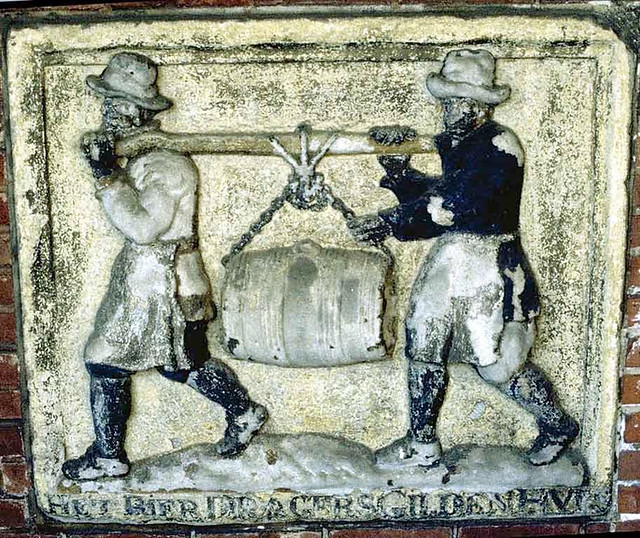
Today we’re heading into the Wayback Machine again, this time to circa 1778 in Leiden, which is in the Netherlands. Back then, the town was spelled “Leyden,” and “like many other cities, had a Jerusalem Chapel, maintained by citizens who had returned from a pilgrimage to the Holy Land.” The Chapel is no longer standing, but part of it was preserved and today can be seen at the Stedelijk Museum De Lakenhal in Leiden. The particular bit from the chapel highlighted today is a Baroque sculpture showing the emblem of the Dutch Beer Carriers Guild.

There’s not much information about the work itself or even who created it. But the notion of a guild for a profession whose only job was transport beer I thought might of interest. Though not Dutch, here’s a description of “The Beer Carriers of Bruges,” from the website of Global Beer, who import several Belgian beers to the U.S.:
It was in 1477 that the municipal authorities forbade breweries from transporting beer within the boundaries of Bruges. At the same time, they created the guild of ‘biervoerders’ (beer carriers). The purpose was to control tax evasion. Tax on beer was the main source of income for a city. For example, at the end of the 16th century, these taxes
represented more than 60 % of the receipts of the city of Antwerpen. Because beer was the normal beverage for every one, with an average consumption of more than a half gallon per head per day, taxing beer was a guaranteed source of income for a city.It must have been a picturesque spectacle in the streets of the inner cities, two men carrying a cask of beer, fixed to long poles resting on their shoulders. Not only the local brewers had to use their services, also the brewers from surrounding areas and the importers, who delivered beer to Bruges, stopped at the gates of the city and gave their loads to the carriers. The carriers had a typical uniform, with the logo of their guild, two casks, embroidered on the front and the back. The president of the guild was named ‘king’.
He had 5 deputies, one for every section of Bruges. Every month, a drawing of lots indicated to which section of the city each beer carrier-team was appointed. Each member of the guild was constrained to face certain obligations, that won them the appreciation of the brewers for their efficiency and their strict neutrality in respect of the different beers that they were appointed to transport. For the carriers, beer was only a merchandise like any other, and they were wise enough to remain outside the rivalries which prevailed between their clients.
A document of 1650 teaches us that a new member of the guild had to pay a certain sum of money, and had to donate a cask of beer during a feast he had to organize to celebrate his entry in the trade. The organization of trades in brotherhoods or guilds, was an early form of social security. Each day, work completed, the carriers met together in their local ‘thuyscken op de markt’ (the little house on the marketsquare) to submit to the paymaster the receipts of their deliveries. At the end of the month, the distribution of profits took place, and all carriers received an identical sum, even those who had been forced to interrupt their work during the month on account of illness.
It was only at the beginning of the 20th century, that the independent carriers disappeared and were replaced by the lorries of the breweries. The guild of the beer carriers was one of the rare guilds, holding a monopoly, that had survived the French Revolution
There’s some more fascinating information about Dutch beer carriers at the genealogical page, Barent Jacobsen Kool and Marritje Leendertse De Grauw, from which there are some interesting tidbits below.
Under the Court Minutes for 1654 (for the Burgomasters and Schepens of this City of New Amsterdam):
And in order to prevent all fraud and smuggling in the one and the other, the Burgomasters and Schepens aforesaid with the approbation of the Honble Director General and Council have appointed and accepted as sworn Wine and Beer Carriers Barent Jacobsen Cool and Pieter Caspersen van Naerden and no person, be he who he may, except such Beer Carriers, shall be at liberty to work at, lay in, or remove any wines or beer from one warehouse, cellar, or brewery to another or to bring foreign beer within this City’s gates on pain of forfeiting said wines or beer and arbitrary correction at the direction of the Court.
And here’s a table of how much they could charge for their services:
The appointed Wine or Beer Carriers for what they may convey here within the walls of this City from one Brewery house or cellar into the other, shall not be permitted to receive more than the following.
For one pipe of brandy………………………………………..24 stivers
one pipe of wine…………………………………………………Twenty stivers
one hogshead of wine…………………………………………Twelve stivers
one Aam (40 gallons) ………………………………………..Ten stivers
one half-aam……………………………………………………..Five stivers
one anker…………………………………………………………Three stivers
half anker…………………………………………………………Two stivers
one tun of strong or small beer…………………………..Eight stivers
one half-barrel………………………………………………….Four stivers
one anker…………………………………………………………Three stivers
And according to the “History of the City of New York in the Seventeenth Century: Volume I: New Amsterdam” by Mariana Griswold Van Rensselaer, there were beer carriers in New York City in the mid-1600s, too.
